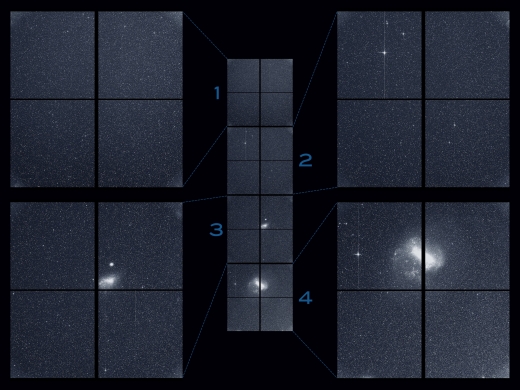Centauri Dreams
Imagining and Planning Interstellar Exploration
Looking Back at Titan
There are two senses in which we are ‘looking back’ at Titan in today’s post. On the one hand, the New Horizons spacecraft has already taken sensors well beyond Pluto in preparation for the encounter with MU69. From its perspective, anything in the Solar System inside the Kuiper Belt is well behind. What with our Pioneers, Voyagers and now New Horizons, the human perspective has widened that far.
But we’re also looking back in terms of time when we revisit the Cassini mission and what it had to tell us about Saturn’s moons. Below is the final view the spacecraft had of Titan’s lakes and seas, a view of the north polar terrain showing the abundance of liquid methane and ethane. The view was acquired on September 11, 2017, a mere four days before Cassini was sent to its fiery end in Saturn’s atmosphere as a way of avoiding any potential future contamination.
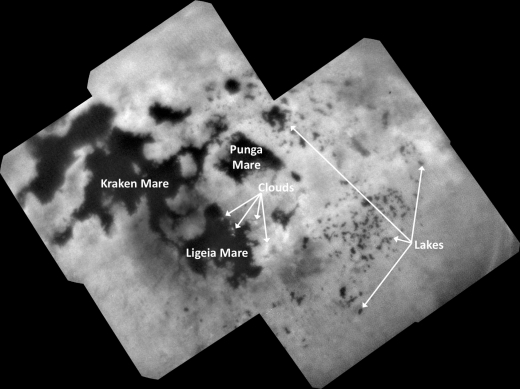
Image: This view of Titan’s northern polar landscape was obtained at a distance of approximately 140,000 kilometers (87,000 miles) from Titan. Image scale is about 800 meters (0.5 miles) per pixel. The image is an orthographic projection centered on 67.19 degrees north latitude, 212.67 degrees west longitude. An orthographic view is most like the view seen by a distant observer looking through a telescope. Credit: NASA/JPL-Caltech/Space Science Institute.
Just above the center of this mosaic is Punga Mare, 390 kilometers (240 miles) across, with Ligeia Mare (500 kilometers, or 300 miles wide) below center. The large body of methane/ethane at left is Kraken Mare, some 1200 kilometers across (730 miles). Note the scattering of small lakes around the seas, especially at the right side of the mosaic.
Also interesting is the small amount of cloud cover, though a few do appear just below center in the image, as well as several above Ligeia Mare. We would expect clouds, since Titan’s methane cycle involves rainfall, surface runoff, collected methane in large bodies like these, and evaporation, much like Earth’s water cycle. And in fact, cloud activity was found during southern summer over the south pole. But here we’re in northern spring and summer, with few clouds.
“We expected more symmetry between the southern and northern summer,” said Elizabeth (“Zibi”) Turtle of the Johns Hopkins Applied Physics Lab and the Cassini Imaging Science Subsystem (ISS) team that captured the image. “In fact, atmospheric models predicted summer clouds over the northern latitudes several years ago. So, the fact that they still hadn’t appeared before the end of the mission is telling us something interesting about Titan’s methane cycle and weather.”
Remember that among the many things Cassini found on Titan are two different kinds of methane/ethane-filled depressions that create the features we see in this mosaic. Some are responsible for the collection of the large seas, which are not only hundreds of kilometers across but evidently several hundred meters deep, all fed by branching channels like rivers on Earth. The much smaller lakes show terrain with steep walls and rounded edges. They do not appear to be associated with incoming channels, meaning they are filled by rainfall or by upwelling from below, and it’s known that some of them fill and dry out during Titan’s seasonal cycle.
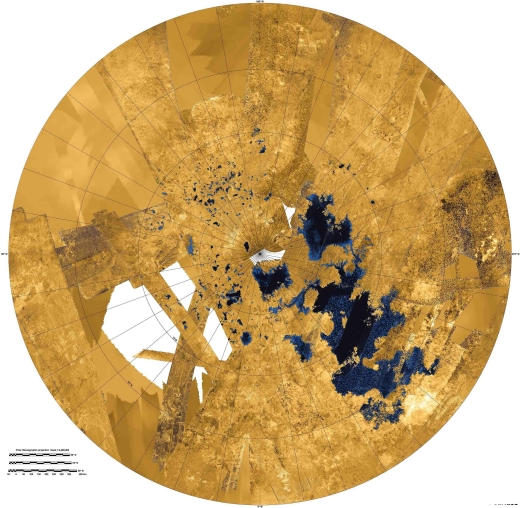
Image: An earlier, colorized mosaic from NASA’s Cassini mission shows Titan’s northern land of lakes and seas. Here the data were obtained from 2004 to 2013. In this projection, the north pole is at the center. The view extends down to 50 degrees north latitude. In this color scheme, liquids appear blue and black depending on the way the radar bounced off the surface. Land areas appear yellow to white. Credit: NASA/JPL-Caltech/Space Science Institute.
In a 2015 study, Thomas Cornet (European Space Agency) and colleagues went to work on Titan’s lakes, noting that they are reminiscent of ‘karstic’ landforms on Earth. On our planet, these result from erosion due to groundwater and rainfall affecting dissolvable rock such as limestone and gypsum, creating both caves and sinkholes or, in desert climates, salt pans.
Cornet’s team worked out how long it would take to create features like this on Titan, assuming a surface covered in organic material, with the main dissolving agent being liquid hydrocarbons operating in a climate based on current models. The result: 50 million years to create a 100-meter (330 ft) depression in the polar regions. Says Cornet:
“We compared the erosion rates of organics in liquid hydrocarbons on Titan with those of carbonate and evaporite minerals in liquid water on Earth. We found that the dissolution process occurs on Titan some 30 times slower than on Earth due to the longer length of Titan’s year and the fact it only rains during Titan summer. Nonetheless, we believe that dissolution is a major cause of landscape evolution on Titan and could be the origin of its lakes.”
Thus we find a process of erosion dependent on rock chemistry, rainfall rate and surface temperature that has similarities with what we see on Earth on what Cornet calls a “relatively youthful billion-year-old surface,” a comparatively slow surface transformation that is even slower at lower latitudes, where the rainfall is less frequent. For more on this, see New Insights into Titan.
The Cornet paper on Titan’s surface features is “Dissolution on Titan and on Earth: Towards the age of Titan’s karstic landscapes,” Journal of Geophysical Research – Planets 25 April 2015 (full text).

TESS, Saint-Exupéry and the Sea

I like nautical metaphors as applied to the stars, my favorite being the words attributed to Antoine de Saint-Exupéry, French writer/aviator and author of poetic works about flight like Wind, Sand and Stars (1939), and a work familiar to most American students of French, Vol de nuit, published in English as Night Flight (1931). I think the Saint-Exupéry quote captures what it takes to contemplate far voyaging:
“If you want to build a ship, don’t drum up the men to gather wood, divide the work and give orders. Instead, teach them to yearn for the vast and endless sea.”
Image: Antoine de Saint-Exupery, whose work inspired, among many other things, my own decision to take up flying.
I had to track down the quote because the last time it appeared in these pages, a reader wrote to tell me he had never found it in Saint-Exupéry. I hadn’t either, which bothered me because I am a huge fan of the man’s work. It certainly sounded like him. So I did some digging and turned up a passage in Saint-Exupéry’s posthumously published Citadelle (1948) that comes close. The quote above is a much abbreviated paraphrase but does capture the spirit of the original (you’ll find a translation of the original at the end of this post).
Looking out over the ocean is much like looking out into the stars, triggering that same sense of immensity and, among some at least, the drive to explore. I get the same triggering effect by looking at images from spacecraft missions, like the views below from the Transiting Exoplanet Survey Satellite (TESS), which has now provided us with a ‘first light’ look at the southern sky.

Image: The Transiting Exoplanet Survey Satellite (TESS) took this snapshot of the Large Magellanic Cloud (right) and the bright star R Doradus (left) with just a single detector of one of its cameras on Tuesday, Aug. 7. The frame is part of a swath of the southern sky TESS captured in its “first light” science image as part of its initial round of data collection. Credit: NASA/MIT/TESS.
So do images of the stars make us yearn for deep space as Saint-Exupéry’s passage makes us yearn for the sea? I suspect so, and it would explain how often we resort to the sea in describing the stars. This morning I can point to Paul Hertz, who is astrophysics division director at NASA Headquarters, a man who likewise resorts to a maritime theme in describing what TESS will do:
“In a sea of stars brimming with new worlds, TESS is casting a wide net and will haul in a bounty of promising planets for further study. This first light science image shows the capabilities of TESS’ cameras, and shows that the mission will realize its incredible potential in our search for another Earth.”
That bounty should reveal numerous nearby targets for the investigation of the James Webb Space Telescope as well as later space- and ground-based instruments. The full four-camera image that is shown below was captured on August 7, and took in constellations from Capricornus to Pictor, and both the Large and Small Magellanic Clouds. This view of the southern sky includes more than a dozen stars already known to have transiting planets.
Image: The Transiting Exoplanet Survey Satellite (TESS) captured this strip of stars and galaxies in the southern sky during one 30-minute period on Tuesday, Aug. 7. Created by combining the view from all four of its cameras, this is TESS’ “first light,” from the first observing sector that will be used for identifying planets around other stars. Notable features in this swath of the southern sky include the Large and Small Magellanic Clouds and a globular cluster called NGC 104, also known as 47 Tucanae. The brightest stars in the image, Beta Gruis and R Doradus, saturated an entire column of camera detector pixels on the satellite’s second and fourth cameras. Credits: NASA/MIT/TESS.
Whereas the Kepler mission ‘stared’ at a single field of stars at distances up to 3,000 light years, TESS puts the same transit detection strategy to work on much closer targets, 30 to 300 light years away, and up to 100 times brighter. The spacecraft will monitor 26 sectors of the sky for 27 days each, ultimately covering 85 percent of the sky, with the first year of operations dedicated to southern stars before beginning the second year-long survey of the northern sky.
The science investigations will include those requested through the TESS Guest Investigator Program, which allows the scientific community at large to use the spacecraft for research.
“We were very pleased with the number of guest investigator proposals we received, and we competitively selected programs for a wide range of science investigations, from studying distant active galaxies to asteroids in our own solar system,” said Padi Boyd, TESS project scientist at NASA’s Goddard Space Flight Center in Greenbelt, Maryland. “And of course, lots of exciting exoplanet and star proposals as well. The science community are chomping at the bit to see the amazing data that TESS will produce and the exciting science discoveries for exoplanets and beyond.”
Here’s a square from the third camera; note the Small Magellanic Cloud just right of center.
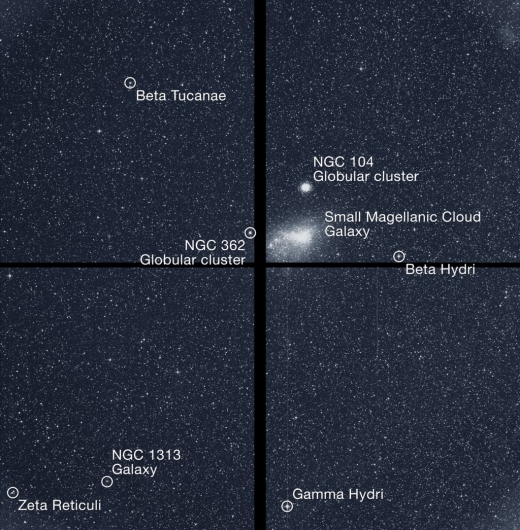
Image: The Transiting Exoplanet Survey Satellite (TESS) captured this square of stars and galaxies in the southern sky with its third camera during one 30-minute period on Tuesday, Aug. 7. Bright objects are labeled. Credit: NASA/MIT/TESS.
A sea of stars indeed, with the TESS targets bright enough for high-grade spectroscopic follow-up. All of this is coming together as part of the extension of our studies to the atmospheres of small, rocky worlds. Yesterday we looked at a paper from Anthony Del Genio et. al. on Proxima Centauri b. The Del Genio paper makes the point that “The population of potentially habitable rocky exoplanets in M star systems has now suddenly reached the point at which it will soon be possible to assess the demographics of this class of planet.”
Exoplanet demographics! We’ve come so far since the first detection of planets around a main sequence star back in 1995. TESS will be a huge part of extending our catalog.
And returning to the Saint-Exupéry passage with which I opened, here is a translation of the passage in La Citadelle that I found online.
One will weave the canvas; another will fell a tree by the light of his ax. Yet another will forge nails, and there will be others who observe the stars to learn how to navigate. And yet all will be as one. Building a boat isn’t about weaving canvas, forging nails, or reading the sky. It’s about giving a shared taste for the sea…
Good stuff, but I admit to liking the abbreviated version better. It has more punch.

Proxima Centauri b: The Habitability Question
Proxima Centauri b is back in the news, although I’ll confess that in my case, it’s rarely out of my thoughts — I’ve been obsessed with the Alpha Centauri system since my youth. The latest comes through work by Anthony Del Genio and colleagues (NASA GSFC), who describe in Astrobiology their new simulations with regard to potential habitability.
You’ll recall the issues here. A planet this close to its host star may well be tidally locked, with one side always facing the M-dwarf Proxima Centauri. Martin Turbet (Sorbonne Universités, Paris) and colleagues described possible climates on Proxima b in a 2016 paper, using a 3D climate model (GCM) to simulate the atmosphere and water cycle of the planet for its two possible rotation modes, a 1:1 and a 3:2 spin resonance (in other words, gravitational forces could keep Centauri b locked to Proxima or rotating 3 times for every 2 orbits of the star).
The Solar System offers analogues: The Moon is in a 1:1 spin resonance with the Earth, while Mercury is in a 3:2 spin resonance with the Sun. What Del Genio and company bring to the table is a model that incorporates these resonances and a global climate model but also includes the effects of an ocean that can transfer heat from one side of the planet to another.
The addition of this dynamic ocean modeling gets us to an interesting outcome: Rather than, as with the Turbet paper, finding an entirely frozen dark side, with a star-facing side that has at least some potential for a sea, Proxima b may have conditions allowing for an equatorial zone of liquid water even on the dark side, with large open ocean possible elsewhere.
This result improves the odds on habitability, as Del Genio is quoted as saying in an article called The Closest Exoplanet to Earth Could Be “Highly Habitable.” An ocean-covered Proxima b with an atmosphere like Earth’s could have open oceans that extend into the dark side, at least at low latitudes, and this turns out to be true both for synchronous rotation and a 3:2 spin-orbit resonance with a somewhat eccentric orbit.
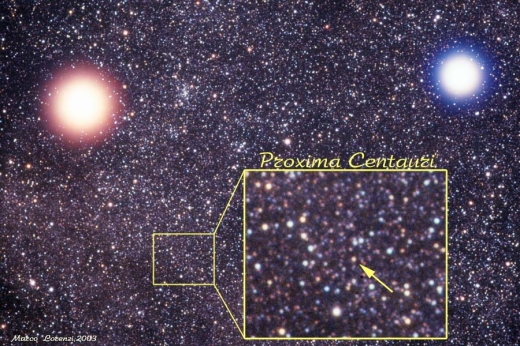
Image: An image of the closest star to the Sun, Promixa Centauri, and its surrounding field of stars. Note that Centauri A and B both appear as a single ‘star’ here, their light combined in the bright object at the left. The bright star on the right is Beta Centauri, which is not a part of the Alpha Centauri system and is much further away from Earth. Credit: Marco Lorenzi.
But in going through the paper, I think it’s important to note that the researchers also derive much colder temperatures than previously suggested, the result of the transport of oceanic heat around the surface. Let’s look at how the paper treats this outcome with reference to Earth:
Because of its weak instellation, however, Proxima Centauri b’s climate is unlikely to resemble modern Earth’s. “Slushball” episodes in Earth’s distant past with cold but above-freezing tropical oceans (Sohl et al, 2017) are better analogs. The extent of open ocean depends on the salinity assumed. Elevated greenhouse gas concentrations produce some additional warming, but this is limited for any M-star planet by the reduced penetration of near-infrared starlight to the surface, and for Proxima b in particular, by its existence near a possible dynamical regime transition.
Unlike Turbet and team, Del Genio’s paper rules out a single ocean at the substellar area — this is sometimes called the ‘eyeball Earth’ scenario — because their dynamic ocean models show enough heat transport to allow water to exist on a wider basis. But note the effect of salinity, which determines the temperature at which seawater freezes. Modeling different levels of salinity in their various simulation scenarios (which also varied atmospheric composition), the scientists found that at high salinity, broad regions of open ocean occur and little ice.
We may have a Proxima b that is habitable but in terms that are starkly different from Earth:
…if we think more broadly about what constitutes a habitable planet (Cullum et al., 2016), it is reasonable to imagine a cold but inhabited Proxima Centauri b with a very salty shallow remnant of an earlier extensive ocean in which halophilic bacteria are the dominant life form, especially if the ocean is in contact with a silicate seafloor (Glein and Shock, 2010).
In an interesting discussion of other exoplanets at the end of the paper, the researchers consider TRAPPIST-1 e, LHS 1140 b, GJ 273 b and other worlds in the context of their models. The point could not be clearer: We are steadily building our inventory of potentially habitable rocky exoplanets around M-dwarfs. Where this paper points is toward continued refinements to climate modeling as we anticipate our first atmospheric detections and characterizations.
Calling the Del Genio paper “a very exciting result indeed,” Guillem Anglada Escudé (Queen Mary University of London), who led the team that discovered Proxima b, likewise pointed to nearby M-dwarf systems and the likelihood that their planets would be rich in water. By ‘rich,’ we are talking about 10-30% in water content, as opposed to < 1 percent for Earth.
The problems of atmosphere retention through early tidal heating and later erosion due to stellar flares and a strong stellar wind are serious and we cannot rule out the possibility that they would make habitability impossible. Anglada Escudé noted these issues in an email this morning, but continued:
“The paper (necessarily) needs to make a large number of assumptions, but this is very important work as it points towards the observational probes that we should soon be able to apply to these planets (temperature, thermal environment, atmospheres rich in water vapor, or whatever). As usual, we would like to see a few more of these simulations by independent teams to obtain a better perspective on the landscape of possibilities.”
Where to next with this research? Anglada-Escudé adds:
“As a shopping list of things that I would like to see from our modeller colleagues, it would be great to see some of these models coupled with erosive effects from stellar activity on the upper atmosphere, and the resulting exotic atmosphere we might expect. That is, even if large chunks are eroded due to a particularly violent coronal mass ejection or flare, the ocean would possibly outgas a new one quickly.”
The paper adds that we have some analogues in our own Solar System to seas of high salinity like those modeled here. Europa, for example, is thought to contain such a sea, as is Enceladus. Interestingly, we can’t observe life signatures within these bodies without going there, setting up a situation in which we may detect — within a few decades — biosignatures on an exoplanet before we find signs of life beyond Earth in our own Solar System.
The paper is Del Genio, “Habitable Climate Scenarios for Proxima Centauri b with a Dynamic Ocean,” published online at Astrobiology 5 September 2018 (preprint). The Turbet paper is “The habitability of Proxima Centauri b II. Possible climates and observability,” Astronomy & Astrophysics Vol. 596, A112 (December, 2016). Abstract

Timing Planetary Migration in the Early System
Given that we’ve been talking lately about collisions and water-delivering impacts in the early days of the Solar System, it’s a natural enough segue to today’s work from the Southwest Research Institute (SwRI) on how the planets themselves may have moved about in that era. We also need to talk about the upcoming Lucy mission, which targets two interesting bodies: Patroclus and Menoetius. Both are approximately 112 kilometers wide, comprising a large binary among the Trojan asteroids, which move in leading and trailing orbits around Jupiter.
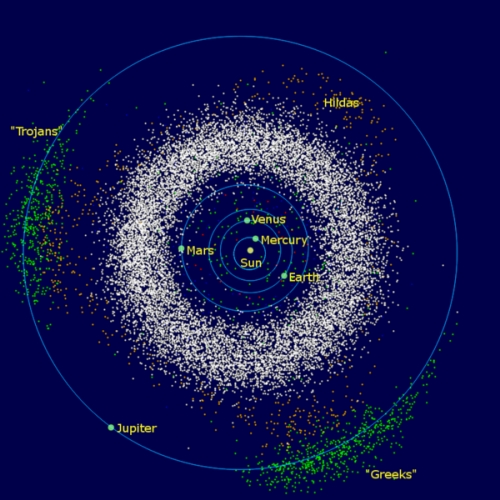
Image: Jupiter’s extensive Trojan asteroids, divided into ‘Trojans’ and ‘Greeks’ in a nod to Homer, but all Trojans nonetheless. Credit: “InnerSolarSystem-en” by Mdf at English Wikipedia – Transferred from en.wikipedia to Commons. Licensed under Public Domain via Commons.
What David Nesvorny and team have done in their recent paper is to look at migration of Solar System planets, with evidence they believe can be pulled from the Patroclus-Menoetius binary Trojan. What a cataclysmic time this must have been, as both Uranus and Neptune were pushed much further from the Sun, where they would have encountered the objects we see in today’s Kuiper Belt. The Trojans tell at least part of the tale. Says Nesvorny:
“The Trojans were likely captured during a dramatic period of dynamic instability when a skirmish between the Solar System’s giant planets — Jupiter, Saturn, Uranus and Neptune — occurred, Many small bodies of this primordial Kuiper Belt were scattered inwards, and a few of those became trapped as Trojan asteroids.”
Nesvorny has already examined the period of planetary migration in a 2012 statistical study analyzing the early Solar System in terms of four, five and six giant planets, deducing the likelihood that Jupiter’s encounters with a Neptune-class planet caused Jupiter to move inward (perhaps a fraction of an AU) even as Neptune migrated outward. Earlier work has seen these events as being associated with the Late Heavy Bombardment, 4.1 to 3.8 billion years ago. The new paper argues for a much earlier period of migration, with the Patroclus-Menoetius binary forming in a once massive planetesimal disk beyond Neptune.
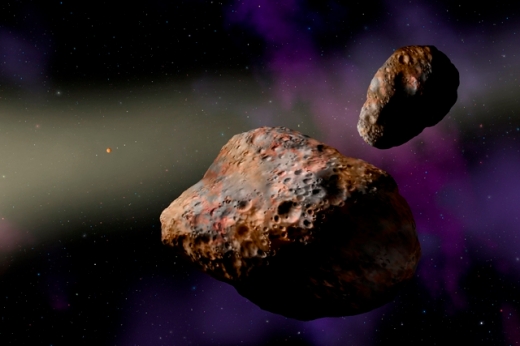
Image: SwRI scientist studied the binary asteroid Patroclus-Menoetius, shown in this artist’s conception, to determine that a shake-up of the giant planets likely happened early in the solar system’s history, within the first 100 million years. Credit: W.M. Keck Observatory/Lynette Cook.
The Lucy mission to study Patroclus-Menoetius comes out of SwRI, with Harold Levison as principal investigator, and is part of the broader investigation into the development of the Solar System. Nesvorny’s work draws on recent work on how small bodies like this binary emerged, with indications that the early Solar System was a place where binary formation was common. Co-author William Bottke at SwRI points to binaries in today’s Kuiper Belt and contrasts their presence with the relatively few that now exist within the orbit of Neptune. What do we make of the difference, and how can we use it to put Patroclus-Menoetius in its proper context?
The researchers think the very existence of the binary Trojan offers information about the chronology of planetary migration. The longer the period of instability was delayed, the more likely that small body binaries in the primordial Solar disk would have been disrupted by collisions, affecting how many binaries would be captured in the population of Trojans. The evidence, then, points to early instability rather than a delay of hundreds of millions of years.
The Late Heavy Bombardment would have ended approximately 700 million years after the dispersal of the protosolar nebula, referenced in the paper as t0, but Nesvorny’s paper argues for planetary migration starting at the time of that dispersal. From the paper:
The outer planetesimal disk at 20-30 au, in which the P-M binary formed, is thought to have been massive (total estimated mass Mdisk ? 20 M?, where M? ? 6 × 1027 g is the Earth mass), as inferred from planetary migration/instability simulations, slow migration of Neptune required to explain the inclination distribution of TNOs [Trans-Neptunian Objects], and the capture probability of JTs [Jupiter Trojans]. The massive disk was subject to intense collisional grinding by impacts between planetesimals. The survival of the P-M binary in such a hostile environment is an important constraint on the disk lifetime, tdisk, defined as the time interval between t0 and the start of Neptune’s migration.
Using simulations within a previously developed collision code, the authors show the sensitivity of the Patroclus-Menoetius binary’s survival to the age of the disk. Just a snippet of this discussion:
Assuming a 100% initial binary fraction, and adopting the 72% dynamical survival probability computed previously, we find that having one P-M binary among the 25 largest JTs with D > 100 km would be a < 0.002 probability event if tdisk ? 400 Myr. The long-lived disks can therefore be ruled out at the 99.8% confidence level.
Because simulations of the survival of Patroclus-Menoetius indicate that the planetesimal disk had to have been dispersed by migrating planets within ? 100 Myr of the dispersal of the protosolar nebula, there is found to be no linkage between planet migration and the Late Heavy Bombardment.
As I mentioned, Harold Levison, who is a co-author on this work, is also the principal investigator of the Lucy mission, which will launch in 2021 and reach the Patroclus-Menoetius binary in 2033. Three imaging and mapping instruments comprising a color imaging and infrared mapping spectrometer, a high-resolution visible imager, and a thermal infrared spectrometer can then be put to work to study the physical properties of these interesting relics.
This is an interesting mission profile, by the way. Lucy will head first for the L4 Trojans, which orbit 60° ahead of Jupiter, where it will study four objects, 3548 Eurybates, 15094 Polymele, 11351 Leucus, and 21900 Orus. A return to Earth and subsequent gravity assist will then take the spacecraft to the L5 Trojan cloud, trailing Jupiter by 60° in its orbit. There, it will study Patroclus-Menoetius, along the way making a flyby of the non-Trojan main belt asteroid 52246 Donaldjohanson, which is named after the discoverer of the famous Lucy hominin fossil. The term ‘hominin’ takes in modern humans but also all extinct human species and ancestors.
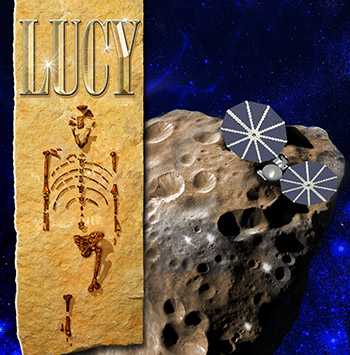
Image: A mission emblem for Lucy, which will study primitive asteroids orbiting near Jupiter, showing the team’s interest in the Lucy hominin skeleton as an example of the earliest period of humans, a study the spacecraft is intended to duplicate for the earliest era of Solar System formation. Credit: SwRI.
The paper is Nesvorny et al., “Evidence for very early migration of the Solar System planets from the Patroclus–Menoetius binary Jupiter Trojan,” Nature Astronomy 10 September 2018 (abstract / preprint).

Water Delivery to the Early Earth
Thinking about supplying a young planet with water, the mind naturally heads for the outer reaches of the Solar System. After all, beyond the ‘snowline,’ where temperatures are cold enough to allow water to condense into ice grains, volatiles are abundant (this also takes in methane, ammonia and carbon dioxide, all of which can condense into ice grains). The idea that comets or water-rich asteroids bumping around in a chaotic early Solar System could deliver the water Earth needed for its oceans makes sense, given our planet’s formation well inside the snowline.
We’ve just looked at Ceres, in celebration of the Dawn mission’s achievements there, and we know that Ceres has an icy mantle and perhaps even an ocean beneath its surface. At 2.7 AU, the dwarf planet is right on the edge of traditional estimates for the snowline as it would have occurred in the early days of planet formation. Obviously, the snowline has a great deal to do with various models about the accretion of solid grains into planetesimals.
If I dig around in the archives, I can even show you an image of a snowline. The star below is V883 Orionis, from a stellar class called FU Orionis, a young, pre-main sequence star capable of major variability in brightness and spectral type. The snowline is easy to find here because an outburst in luminosity has heated up the protoplanetary disk, pushing the snowline outwards.
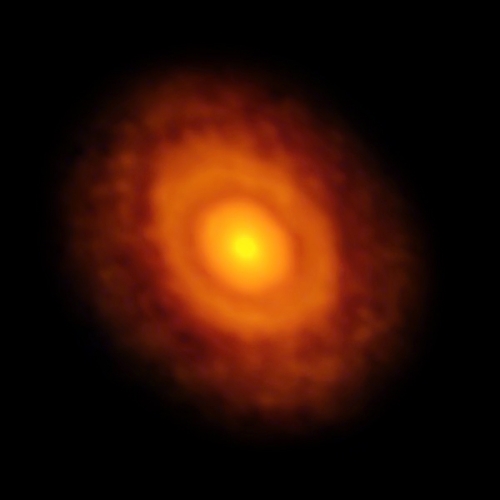
Image: This image of the planet-forming disc around the young star V883 Orionis was obtained by ALMA in long-baseline mode. This star is currently in outburst, which has pushed the water snowline further from the star and allowed it to be detected for the first time. The dark ring midway through the disc is the water snowline, the point from the star where the temperature and pressure dip low enough for water ice to form. Credit: ALMA (ESO/NAOJ/NRAO)/L. Cieza.
As sound an idea as water delivery via objects from beyond the snowline seems, it’s always wise to question our assumptions, and indeed, the issue is strongly debated. For a second scenario for Earth’s water is available. This is the idea that enough water-rich dust grains can accumulate to form boulders of kilometer size, objects that can contain large enough amounts of water to explain the amount we have on Earth. This is the so-called ‘wet-endogenous scenario,’ in which water in the early, still accreting Earth occurs in the form of hydrous silicates.
An interesting take on this comes from Martina D’Angelo (University of Groningen, the Netherlands) and colleagues, with a second paper in the process from W. F. Thi (Max Planck Institute for Extraterrestrial Physics) and team. How to defend the latter scenario given Earth’s formation well inside the snowline? The answer may lie in sheets of silicate materials called phyllosilicates, which as I’ve learned in preparing this piece, include the micas, chlorite, serpentine, talc, and the clay minerals. Usefully, they have interesting properties when it comes to water, retaining it when heated up to several hundreds of degrees centigrade.
Thus D’Angelo, supported by earlier work, notes that there is a way to preserve structural water even in the warmer regions of the protoplanetary disk. D’Angelo’s paper, supported by the still unpublished work of Thi’s team, explores how water from the gas phase can diffuse into the silicates well before the dust grains of the inner system have accreted into planetesimals.
The paper explains the astrophysical models for protoplanetary disks and the Monte Carlo simulations used for studying ice accretion on grains that were used in this work. The simulations show water vapor abundances, temperature and pressure radial profiles that identify where in the protoplanetary disk hydration of dust grains could have occurred. The results show that the ‘wet endogenous scenario’ can by no means be ruled out. From the paper, addressing the simulation results for water adsorption on a forsterite crystal lattice:
Our MC [Monte Carlo] models show that complete surface water coverage is reached for temperatures between 300 and 500 K. For hotter environments (600, 700 and 800 K), less than 30% of the surface is hydrated. At low water vapor density and high temperature, water cluster formation plays a crucial role in enhancing the coverage… The binding energy of adsorbed water molecules increases with the number of occupied neighboring sites, enabling a more temperature-stable water layer to form. Lateral diffusion of water molecules lowers the timescale for surface hydration by water vapor condensation by three order of magnitude with respect to an SCT model, ruling out any doubts on the efficiency of such process in a nebular setting.
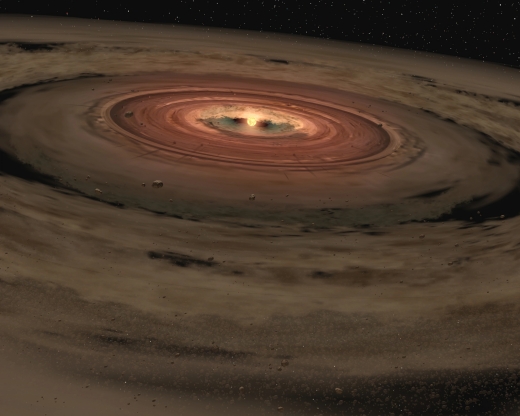
Image: Artist impression of a very young star surrounded by a disk of gas and dust. Scientists suspect that rocky planets such as the Earth are formed from these materials. Credit & Copyright: NASA/JPL-Caltech.
D’Angelo and colleagues believe that between 0.5 and 10 Earth oceans worth of water can be produced by the agglomeration of hydrated grains in an Earth-sized planet in formation, depending on size differences among the grains. The timescale in question fits easily into the time necessary for grains to eventually accrete into larger boulders within the early Solar nebula. Now needed are simulations of grain growth that will help the researchers understand how water is retained on grain surfaces through periods of accumulation and collision.
So it may be that we have twin processes at work, with delivery of water from comets and asteroids playing a role in bulking up a young world with a latent supply of its own water.
The papers are Thi et al., “Warm dust surface chemistry in protoplanetary disks – Formation of phyllosilicates,” submitted to Astronomy & Astrophysics, and D’Angelo et al., “On water delivery in the inner solar nebula: Monte Carlo simulations of forsterite hydration,” accepted at Astronomy & Astrophysics (preprint).

FRB 121102: New Bursts From Older Data
“Not all discoveries come from new observations,” says Pete Worden, in a comment referring to original thinking as applied to an existing dataset. Worden is executive director of the Breakthrough Initiatives program, which includes Breakthrough Listen, an ambitious attempt to use SETI techniques to search for signs of technological activity in the universe. Note that last word: The targets Breakthrough Listen examines do extend to about one million stars in the stellar neighborhood, but they also go well outside the Milky Way, with 100 galaxies being studied in a range of radio and optical bands.
A major and sometimes neglected aspect of SETI as it is reported in the media is the fact that such careful observation can turn up highly useful astronomical information unrelated to any extraterrestrial technologies. Worden’s comment underlines the fact that we are generating vast data archives as our multiplying space- and ground-based instruments continue to scan the heavens at various wavelengths. It is not inconceivable that the signature of a distant civilization or a novel astrophysical process is buried deep within data that is years or decades old.
The case in point this morning comes through Breakthrough Listen’s observations of the Fast Radio Burst (FRB) 121102. FRBs seize the attention because they are a recent and puzzling detection. The first, the so-called Lorimer Burst (FRB 010724) was found no more than eleven years ago. FRBs are also highly unusual, appearing as radio pulses of extremely short duration, usually milliseconds. They are believed to originate in distant galaxies and one of them, FRB 121102, stands out because unlike all others thus far detected, it sends out repeat bursts.

Image: The FRB in question. This is a Gemini composite image of the field around FRB 121102 (indicated). The dwarf host galaxy was imaged, and spectroscopy performed, using the Gemini Multi-Object Spectrograph (GMOS) on the Gemini North telescope on Maunakea in Hawai’i. Data were obtained on October 24-25 and November 2, 2016, before the subsequent Breakthrough Listen observations at Green Bank. Credit: Gemini Observatory/AURA/NSF/NRC.
FRB 121102 is prolific in repeat bursts, as it turns out, and this is where Worden’s words resonate. Earlier studies have shown that the source is located in a galaxy some 3 billion light years away. Breakthrough Listen’s observing team at the University of California, Berkeley SETI Research Center went to work on this ‘repeater’ on August 26, 2017, finding a total of 21 bursts in data acquired at the Green Bank Telescope in West Virginia. All of these turned up within a single hour, which implies periods of intense activity. For more, see New Activity of Repeating FRB 121102.
Working with the same dataset, UC Berkeley graduate student Gerry Zhang and collaborators have now introduced a new machine learning algorithm into the mix, subjecting the same dataset (about 400 TB) to techniques not dissimilar to those used by Internet technology companies. Zhang and team’s ‘convolutional neural network’ was trained to recognize FRBs in the same way that Vishal Gajjar applied when he and his own colleagues analyzed the data in 2017. The algorithm was then applied to the raw data to see if anything new could be acquired.
From the paper:
…we present a re-analysis of the C-band observation by Breakthrough Listen on August 26, 2017 with convolutional neural networks. Recent rapid development of deep learning, and in particular, convolutional neural networks (CNN; Krizhevsky et al. 2012; Simonyan & Zisserman 2014; He et al. 2015; Szegedy et al. 2014) has enabled revolutionary improvements to signal classification, pattern recognition in all fields of data science such as, but not limited to computer image processing, medicine, and autonomous driving. In this work, we present the first successful application of deep learning to direct detection of fast radio transient signals in raw spectrogram data.
The result: 72 new detections of pulses from FRB 121102. That takes the cumulative total from this dataset to 93 pulses in five hours of observation, including 45 pulses within the first 30 minutes. As to periodicity, the work shows that the pulses are not received in a regular pattern. Using the same methods, Zhang and team go on to explore trends in pulse fluence, pulse detection rate, and pulse frequency structure. The breadth of the analysis is made possible by the sheer number of pulses, the highest detected from a single observation, and the use of Zhang and team’s neural network technology, which can surely be adapted to other datasets.
“Gerry’s work is exciting not just because it helps us understand the dynamic behavior of FRBs in more detail,” says Berkeley SETI Research Center Director and Breakthrough Listen Principal Investigator Dr. Andrew Siemion, “but also because of the promise it shows for using machine learning to detect signals missed by classical algorithms.”
So can we be sure we are dealing with a natural astrophysical phenomenon, or is there any possibility of a technology behind this repeating FRB? The data here do not give us the answer, but it’s intriguing to speculate about galactic SETI in light of our recent discussion of the work of Yuki Nishino and Naoki Seto (Kyoto University), who have suggested that natural phenomena such as the merger of a binary neutron star system like GW170817 could be used as a marker to flag a message from a civilization attempting to announce its presence to the cosmos.
For that matter, are all FRBs the same? We’ve only found the one repeater thus far, but 104 are now thought to occur in our sky on a daily basis. Avi Loeb and Minasvi Lingam (Harvard University) have worked out an FRB rate for each galaxy within 100 Gpc3 of about 10-5 per day, if indeed we are dealing with natural sources like gamma ray bursts or neutron star mergers. And as they’ve noted in a recent paper, one of these going off in our own galaxy, as would be expected about every 300 years, would resolve the question of FRB origins, a doubtless spectacular event if occurring nearby.
The Gajjar et al. paper reporting on the 2017 repeat detections is “Highest-frequency detection of FRB 121102 at 4-8 GHz using the Breakthrough Listen Digital Backend at the Green Bank Telescope,” accepted at The Astrophysical Journal (preprint). The Zhang et al. paper covering the subsequent new analysis is “Fast Radio Burst 121102 Pulse Detection and Periodicity: A Machine Learning Approach,” accepted for publication in The Astrophysical Journal, with further details available here. Avi Loeb and Minasvi Lingam’s paper on technological possibilities in FRBs is “Fast Radio Bursts from Extragalactic Light Sails,” The Astrophysical Journal Letters Vol. 837, No. 2 (March 8, 2017). Abstract / preprint.

